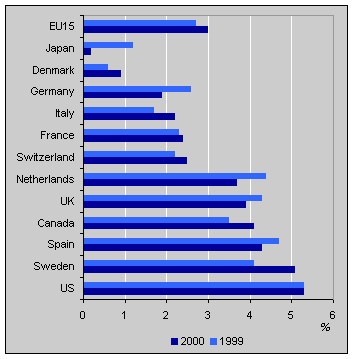Substantial rise in household spending

In an international perspective the Dutch growth rate in household consumption was high. The USA and Sweden led the field in consumer spending growth in 2000, with increase rates of over 5%. In the EU spending in Spain, the UK and the Netherlands was relatively high and well above the EU average.
Household consumption (percentage changes on previous year)

The abundant growth in American household consumption created a substantial deficit on the US trade balance. In the first six months of 2000 spending on durable consumer goods increased by as much as 12%, and as US manufacturers could no longer cope with the demand, goods had to be imported. In this respect a more modest increase in US consumption might not be a bad thing if it stopped the increase of the trade gap. To this end the Federal Reserve System (Fed) raised interest rates several times in the course of 2000. However, because of the usual time lag, the effect this had on consumption only became visible in the fourth quarter, when the consumption of durable goods grew by just 5%. As a slower growth rate in expenditure could slow the US economy down too much, the Fed reduced interest rates substantially at the beginning of 2001.
Frans van Ingen Schenau